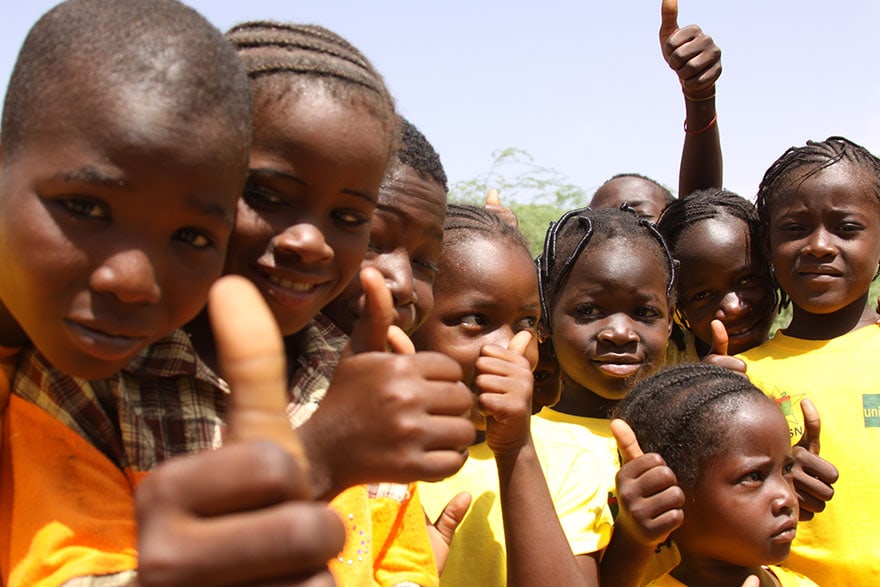The population of the African continent is growing rapidly. Estimated at 140 million in 1900, it reached one billion in 2010. It will reach 2.5 in 2050 and more than 4 in 2100, middle scenario of the United Nations projections (see figure below). One human being in six now lives in Africa. In 2050, it will be 1 in 4, and more than 1 in 3 in 2100, according to the same projections. What is the reason for this strong growth? Will it continue? Is a quadrupling by the end of the century inevitable?

Gilles Pison (from UN data)
Reasons for growth
Africa's population is growing because of the excess of births over deaths (four times as many of births than deaths). Mortality may be the highest in the world, but it has decreased, as it had previously in other continents.
Fertility there is also decreasedThe average number of children born to women in the region will be 4.5 in 2017, compared to more than 6.5 forty years ago and 5.5 twenty years ago. Here too, Africa is experiencing a trend that has already taken place in other continents, where it is more advanced: only 2.1 children per woman in Asia in 2017, 2.0 in Latin America, 1.9 in North America and 1.6 in Europe.
This lower mortality and still relatively high fertility explain why Africa's population is growing rapidly. Even if fertility continues to decline, as assumed in the United Nations medium scenario, this will not immediately result in a significant decline in the growth rate, let alone a halt in growth, because of demographic inertia.
Assuming that African fertility falls to 1.6 children per woman now as it has in the past, it is likely that the African fertility rate will fall to 1.6 children per woman by 2015. Europe or China - highly unlikely scenario, the population would continue to grow for a few more decades to reach nearly 1.6 billion in 2050. Africa's population includes many young adults of childbearing age; even if each had few children, the result would be a high number of births.
Fertility trends: several recent surprises
The population projections published by the United Nations in 1981 predicted 10.5 billion people on the planet in 2100 in their medium scenario. The latest projections, published in June 2017, predict that there will be 11,2which is 0.7 more.
The total is therefore a little higher, but the real change is in the distribution by continent: Asia, with 5.9 billion inhabitants in 2100 according to the projection published in 1981, has only 4.8 billion left by 2017. The revision is also downward for Latin America: 712 million in 2100 instead of 1,187 (40 % less). Conversely, Africa, with a population of 2.2 billion in 2100 according to 1981 projections, has twice as many, 4.4 billion, in those published in 2017 (see figure below).
The first surprise: Surveys reveal that fertility began to decline very rapidly in many countries in Asia and Latin America 30 to 40 years ago. As a result, the United Nations has revised its population projections for these continents downwards significantly.
Another, more recent surprise came from intertropical Africa: its fertility was expected to decline later than in Asia and Latin America because of its lagging socio-economic development, but a simple time lag was imagined, with a similar rate of decline to other regions in the South once it was committed. This is what has happened in Northern and Southern Africa, but not in intertropical Africa, where fertility decline, although now under way, is taking place. slower. Hence an increase in the projections for Africa, which could therefore have more than one in three of the world's inhabitants in 2100.
Gilles Pison (from UN data)
What's happening in intertropical Africa
Fertility is declining well in intertropical Africa, but in educated areas and in cities more than in the countryside, where the majority of the population still lives. Several factors could explain why fertility decline is currently slower in intertropical Africa than it was a few decades ago in Asia and Latin America (see figure below).
Africa is developing economically, slowlyThe fertility rate of the world's poorest countries has not yet reached the level of the Asian or Latin American countries at the time when their fertility began to decline sharply.
Economic development and fertility decline often go hand in hand, with the latter often seen as a consequence of the former. Women's education is a key factor in this process: women who have been to school give birth to fewer children than those who have not. Asian and Latin American countries have been able to reduce the number of children born to women. substantial investment in education for all a few decades ago. While education is making progress in intertropical Africa, especially among women, it is still doesn't reach the levels observed in Asia and Latin America when fertility declined in those continents.
Another factor cited to explain the lower fertility decline in Africa is the cost sharing to raise the children. In Africa, some children are raised by adults other than their parents - a grandparent, uncle, aunt - who pay for their food, clothing and schooling. All over the world, people are gradually making the choice to have few children, investing in each of them to ensure a long and good quality life, which is not possible when there are many. But if having one more child does not lead to increased expenditure because it will be taken care of by others, the incentive to have few children remains less.

Gilles Pison (from UN data)
Elites with little commitment to birth control
Fertility is declining more slowly in Africa than it did in Asia and Latin America a few decades ago; and this is not because Africans are not using contraception.
While most rural families have not yet converted to the two-child model, they do want to have fewer children, and in particular, more widely spaced children. They are ready to use contraception but do not benefit from the new model. no special services to get there.
National birth control programmes exist but are not very effective, lack resources and, above all, suffer from a lack of motivation on the part of their managers and the staff responsible for implementing them in the field. Among the few exceptions are Rwanda, Ethiopia, and Malawi, where the authorities are highly committed to supporting small families and have made fertility reduction one of their priorities.
In Rwanda, it has experienced one of the steepest declines on the continent, falling by more than 20 % in a decade (it has fallen from 5.4 children per woman in the early 2000s to 4.2 in the early 2010s). But in most other countries in intertropical Africa, officials and elites are not convinced of the value of birth control even at the highest levels of government.Stateeven if it is not the official discourse to international organizations. This is again one of the differences with Asia and Latin America in the 1960s and 1970s.
The question of the "demographic dividend"
In order to convince African governments to make birth control a priority, the international bodies are promising them a "demographic dividend".
Indeed, when fertility falls rapidly in a country, the share of young people declines sharply without the share of older people increasing significantly at first. As a result, the share of the working-age population rises sharply, providing an opportunity for the country to thrive. This favourable situation only lasts for a moment. A few decades later, the very large number of people of working age have aged and thus considerably increase the weight of the elderly population.
It is estimated that a number of Asian countries, including China, have benefited from this dividend and that it may have represented up to 10 to 30 % of their economic growth. In contrast, most Latin American countries would not have benefited from this, due to a lack of job creation in sufficient quantity to employ the additional people of working age.
But if Asia and Latin America have committed themselves to the small family, it is not in the hope of benefiting from a demographic dividend - this was not talked about at the time. Governments developed birth control policies to reduce population growth that was considered too rapid for the country's development.
In the case of Africa, the conditions for a demographic dividend to take place are as follows are not together fertility is declining at too slow a pace; and assuming that it starts to decline rapidly, the prospects for job growth are modest and are unlikely to allow to absorb the extra manpower. In the unlikely event that there is a demographic dividend, it is only a distant prospect, a few decades from now.
Africa will not escape a doubling of its population by 2050 because of the demographic inertia that no one can prevent. Depending on its economic development over the next few years, the increase in education among women and policies in favour of small families, by 2100 it will be three, four, five, or six times larger than today.
Gilles PisonProfessor at the National Museum of Natural History and Associate Researcher at INED, National Museum of Natural History (MNHN) - Sorbonne University
This article was originally published on The Conversation. Read the original article.













